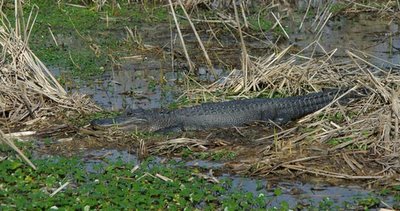Alligators occupy a variety of wetland habitats throughout the United State. They normally are found in marshes, swamps, rivers, farm ponds and lakes in the wild, but also have been found in ditches, neighborhoods, drainage canals, retention ponds, roadways, golf course ponds and sometimes in swimming pools. They have even been documented in the Home and Garden section at Wal Mart! Although these is an extreme example, gators are willing to roam and move into unoccupied wetland habitat.
Nearly any water body that drains into the Gulf of Mexico has the potential to harbor alligators. In addition, coastal prairies along this area, as well as the lower Antlantic coast are likely hot spots as well. During courtship and breeding, which takes place from April to May, alligators prefer open waters. During the remainder of the year, males prefer open and deep waters while females seek out nesting habitat in secluded areas with shallow water and heavy vegetation.
Alligators occur from the southern tip of Texas to the northeastern part of North Carolina. Alligators, though sparse, have invaded some southern portions of Oklahoma by moving up major river drainages. In South Carolina, they are typically found south of the fall line. However, alligators can not survive and reproduce above a certain latitude. There is no evidence that alligator populations reproduce north of the fall line, and it is suspected that many of the alligators found above the fall line may have been illegally relocated. The movement of gators by humans does occur on a regular basis, and usually results in animals displaced from suitable habitat.

However, a small number of individual alligators naturally show up in these out-lying areas. But alligators usually remain in the area where they were hatched for two to three years before establishing their own range. Females generally have small home ranges, while males may occupy a home territory of more than two square miles. Severe drought or flood conditions may cause alligators to move considerable distances in search of suitable waters.
Alligators are ecologically important wildlife species. Because of this, most states that have gators have structured alligator management programs that allow recreational gator hunting. These reptiles help maintain the population balance of certain prey species and they help shape and modify the habitat where they are found. During times of severe drought, alligators are known to dig holes, commonly referred to as simply gator holes, to concentrate water. This helps the alligator survive, and provides a water source to many other species of plants and animals in the area.
